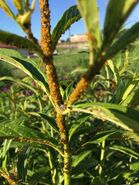An Informal Briefing of Summer 2018 Complications and Successes of the Spire Waystation
The originally planned 100ft2 practically doubled its size as we expanded the garden south, towards the edge of them parking lot. There were a variety of successes but also many unplanned complications that required research and experimentation. I hope the waystation will continue for years to come, as it endures essential conservation of variety of species, below I will offer advice on how this can be accomplished.
1. In retrospect, the garden would have been best placed closer to a running water source, as our original ideas included this detail, however the bioretention cell is a better location in terms of sunlight availability and simply just geographically a better location for wildlife to flourish. This unfortunately brings about the complications of using the water storage tank as the main source of nourishment for the plants. This tank holds 50 gallons of water, and luckily—it has wheels. While taking care of the garden this summer, dragging the tank back and forth every day really did get a litle old but I kept doing it. Perhaps the most unfortunate thing about it though is having to use 2 gallon watering cans to water the entire garden. This process takes up to an hour to complete, and seemed to average around 30 gallons per session. I watered almost everyday, however in late summer I began to do so every other day, as our plants were established finely into their substrate. The best way to get through the daily watering is to truly enjoy it, watch the insects as they come and go, the biorientation cell just to the east is full of life. Early morning or even just before sunset are the best times to water the garden, just fit it into your daily routine!
2. You will encounter many forms of life, and you probably won’t be able to identify all of the insects or plants you come across. A very handy cellphone application that you can try is iNaturalist. This app has a great base of algorithms that aid in the identification of species, is will sometimes just give you a genus name, or if the picture is clear and well-defined it may be able to detect an actual species. If no match is made you can post it and those in the community that interact on the app can help in the identification. Below I will list common insects that I came across:
- Oleander aphids; little orange/yellow true bugs that will suck the life out of your milkweed! The moment you see these guys start to pact together in the garden start exterminating. A mechanical method of removal is probably the best, gently wipe them between your fingers, it is easiest if you use a bit of dripping water while you do this. Another method you can use is a mild water and dish soap solution, simply spray the aphids and the next day there should be their black corpse left, it is best if you wash it off with a bit of water to clean the milkweed. Lady bugs are often used as a biological control method, but the summer of 2018, they didn’t seem to eat them quite fast enough.
- Milkweed bugs; these little orange and black oblong insects will live on the milkweed, but really aren’t too much trouble, just keep them sparingly.
- Japanese Beetles; Yes, the dreaded, extremely invasive and destructive little pest. These guys were the worst in early and late June, covering milkweed and marigolds and eating them clean! I didn’t intervene much with this pest, other than a quick little pat to fly away, however in late July I have not seen them much at all.
- Many species in the lepidoptera order; Grass Skippers, Eastern Tiger Swallowtail, White-Lined Sphinx Moth, Variegated Fritillary, and of course the Monarch butterfly. All great pollinators and enjoyable to watch in the garden.
- Mammals… and marsupials; There were some instances of biostratinomy, or instances where I encountered dead Eastern Moles lying in the garden, as well as just adjacent to it. There seemed to be some predator attacks on both the Eastern Moles and Virginia Opossums. In these instances, I gently placed the deceased body east of the garden, to continue the chemical cycling process.
3. You must weed the garden. Weeding is important to keep the plants we want alive, as weeds take up space/resources and are direct competition with our flowers, and most of the time they are better apt to win. Weeding biweekly has been generally successful. No pesticide use is permitted in the Waystation.
4. Just enjoy it
I recommend reading the article, A Citizen Army for Science: Quantifying the Contributions of Citizen Scientists to our Understanding of the Monarch Butterfly Biology, by Leslie Ries and Karen Oberhauser.
There is also a good documentary film about the migration and Fred Urquhart called Flight of the Butterflies.
A slideshow from monarch larva to adult is shown below.
Some common species you may encounter are shown below.











